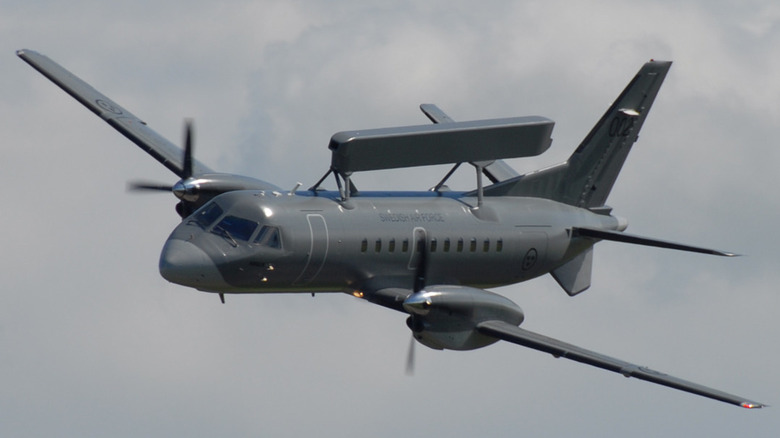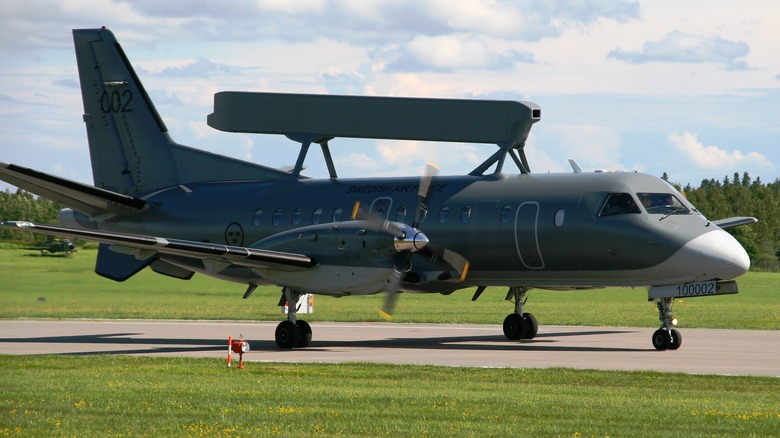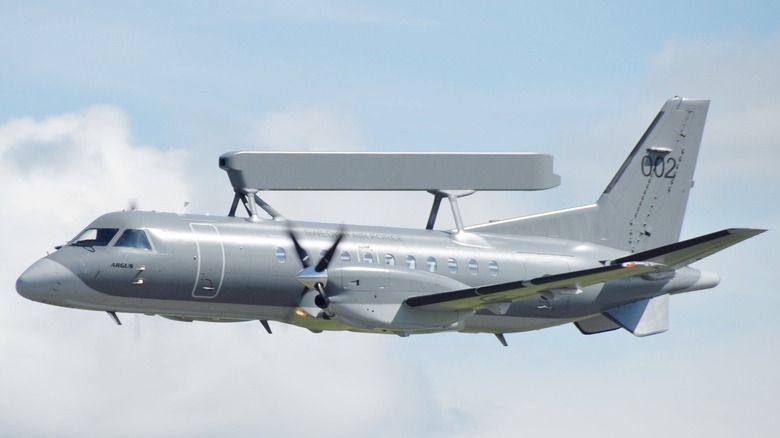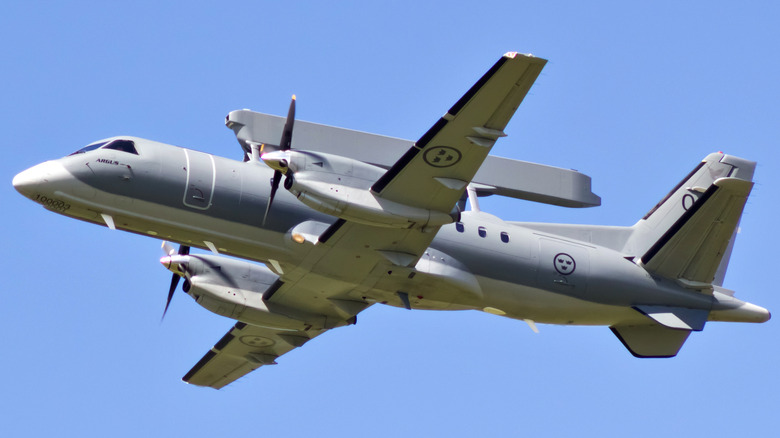Sweden Is Sending Recon Planes To Ukraine: Here's What They Can Do
On May 29, 2024, the Swedish Ministry of Defense announced its plans to hand over a new air asset to Ukraine. As part of its 16th military support package to Ukraine, Sweden will send its Saab Airborne Surveillance and Control (ASC 890) aircraft, equipped with the airborne early warning and control (AEW&C) system. The announcement came just a day after Belgium stated that 30 of its F-16 fighter jets are heading to Ukraine in the next few months.
The ASC 890 — designated S-100B Argus in the Swedish Air Force — is a militarized variant of the turboprop-driven Saab 340 commercial airliner. While it shares a similar airframe with its civilian counterpart, the ASC 890 has one distinct physical feature: a 29-foot "plank" mounted on the top of its fuselage. This odd plank is actually an active electronically scanned array (AESA) radar system called the PS-890 Erieye, and it's sensitive enough to detect a boat-sized target up to 100 nautical miles away.
Besides enhancing Ukraine's ability to monitor its airspace and coordinate defenses against Russian missile and drone threats, the ASC 890's battle management capabilities and datalink will allow the Ukrainian Air Force to get maximum use out of its new F-16s once they arrive. The Swedish Air Force currently operates two aircraft of this type. While the announcement doesn't clarify how many Sweden will donate, the odds are high that Sweden is handing over both jets.
[Featured image by Gnolam via Wikimedia Commons | Cropped and scaled | CC BY-SA 3.0]
The Erieye radar is designed to be small and cheap
In the 1990s, Sweden had a highly capable integrated air defense system (IADS), but there were still small pockets of airspace where it has no radar coverage. To address these radar gaps, the Swedish Air Force tasked Ericsson Microwave Systems (now Saab Electronic Defense Systems) with designing and building a lightweight and cost-effective airborne radar system.
The result of this venture was the PS-890 Erieye, a system capable of being mounted on various commercial frames. Besides making it cheaper to operate, its adaptability also opens up the door for exports. As of early 2024, the Erieye was in service with eight other countries besides Sweden on various "host" airframes.
To meet the requirements, Ericsson had to limit the active antenna face to around 29 feet — which explains why the "dorsal unit" has a narrow, plank-like shape. Additionally, Ericsson also had to make sure that the radar didn't weigh a literal ton, and the final design weighed in at just about 1,985 pounds. That's quite a feat, considering the dorsal unit also houses subsystems like electronic warfare support measure (ESM) and identification friend-or-foe (IFF) antennae.
[Featured image by KGG1951 via Wikimedia Commons | Cropped and scaled | CC BY-SA 3.0]
Highly capable despite the size
Despite its size, the Erieye is a highly capable radar. Unlike mechanically scanned array (MSA) technology, the Erieye's AESA architecture means it doesn't have to physically rotate to sweep the airspace. Instead, its 192 transmit/receive modules (TRMs) can electronically "steer" their own beams without shifting the radar unit itself.
AESA radars like the Erieye also offer many other benefits. They only need a single scan to confirm and track a target by doing a "confirmation dwell" — steering the beam back and illuminating the target to see if it's really there. Older radars, on the other hand, require multiple scans. AESA radars can also "fix" their beam on a specific sector of the skies, providing a much faster track refresh rate for targets in that prioritized sector. Old radars can't do this — they must rotate 360 degrees before they can revisit a sector again.
The Erieye is most precise in detecting and tracking targets within a 150-degree sector on either side of the aircraft (the operator can only work with one side at a time, however.) Since it doesn't have an end-fire array like the one found on the E-7 Wedgetail's MESA radar, the Erieye has decreased performance in the 30-degree sectors in front and aft the aircraft. It can still detect targets in these zones, but can't track them — in that case, the pilots can reorient the plane.
[Featured image by Gnolam via Wikimedia Commons | Cropped and scaled | CC BY-SA 3.0]
How the ASC 890 can bolster Ukrainian airpower
The ASC 890 typically operates at 20,000 feet, far above terrain obstructions that limit ground-based radars. This vantage point allows the aircraft and its radar to detect targets as far as 280 miles away. For fighter-sized objects, the radar can lock onto them when they get within 210 miles. This far-seeing capability will prove invaluable against Russian cruise missile and glide bomb attacks, as well as low-and-slow-flying kamikaze drone swarms.
Notably, the ASC 890 is compatible with NATO command and control architecture, allowing it to pass tracking data down to Western-provided ground-based air defense systems like Patriot Air Defense System and NASAMS via datalink, making them more effective at intercepting threats. Once the F-16s arrive in Ukraine, the ASC 890 can be packaged with them as a "battle manager." The three-man mission crew onboard can direct air assets to intercept pop-up threats as they come within scope. F-16s — compatible with Link-16 — can be managed easily by the ASC 890, while Soviet-era fighters in Ukrainian service, like the Mig-29, may be directed by radio only.
With only two units available at most, the ASC 890 is set to become the most important and protected asset in the Ukrainian Air Force — even more than the F-16s. It'll be interesting to see how the Ukrainians strategize the use of these aircraft in the upcoming months.
[Featured image by Bene Riobó via Wikimedia Commons | Cropped and scaled | CC BY-SA 4.0]



